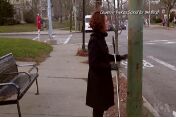正文
VOA常速英语:应用程序帮盲人找到公车站

Imagine being lost and unable to find the nearest bus stop.
Now imagine looking for that same bus stop as a blind person.
“If there are no sighted people available to guide you to the bus stop, or to alert you to when the bus is coming, you are out of luck.”
Using a smartphone’s voiceover and GPS functions can help, but there’s a catch.
“GPS gets you to within about 30 feet of your final destination.But that last 30 feet, when you are blind, is the last 30 feet of frustration, because you can’t get to your precise goal.”
And that could mean being left behind.
But in Boston, the BlindWays app enlists the public’s eyes to help the blind.
“We designed an accurate way for people to contribute clues that are landmarks around the bus stop.They could be a mailbox, a fire hydrant, a bench, a tree.And those become something that a visually impaired person could listen to on blind ways as they are navigating. ”
For the blind, the app helps create a mental map leading to a bus stop.
“Independence and autonomy, and not having to rely on, you know, more segregated types of transportation,that’s really what visually impaired people want.”
Through public crowdsourcing, BlindWays has covered 5,200 of Boston’s 7,800 bus stops.And its creators want to replicate their efforts in other cities.
“We’re all getting more and more used to living in a mobile world and therefore,we could contribute anywhere and anytime to help a colleague or somebody in our community.It’s a powerful model for us, I think we’re going to see more.”
For the blind and visually impaired, seeing more means the ability to do more, one ride at a time.
Tina Trinh, VOA news.
- 上一篇

- 下一篇

相关文章
- VOA常速英语:日增20万确诊病例,印度疫情失控
- VOA常速英语:美国驱逐10名俄罗斯外交官
- VOA常速英语:US Marks One Year of Pandemic Shutdown with Hope, Concern
- VOA常速英语:US Senate Nears Vote on $1.9 Trillion Biden COVID Aid Package
- VOA常速英语:What Is Clubhouse and Why Did It Get So Popular?
- VOA常速英语:Thermal Water Helps Recovering COVID Patients
- VOA常速英语:Deadly Drug Overdoses Epidemic Rages On
- VOA常速英语:International Women’s Day Marks Year of Increased Hardships for Women Worldwide
- VOA常速英语:US States Relax Restrictions, Health Officials Warn Against It
- VOA常速英语:Virginia Starts Reopening Schools for In-Person Learning


 手机网站
手机网站